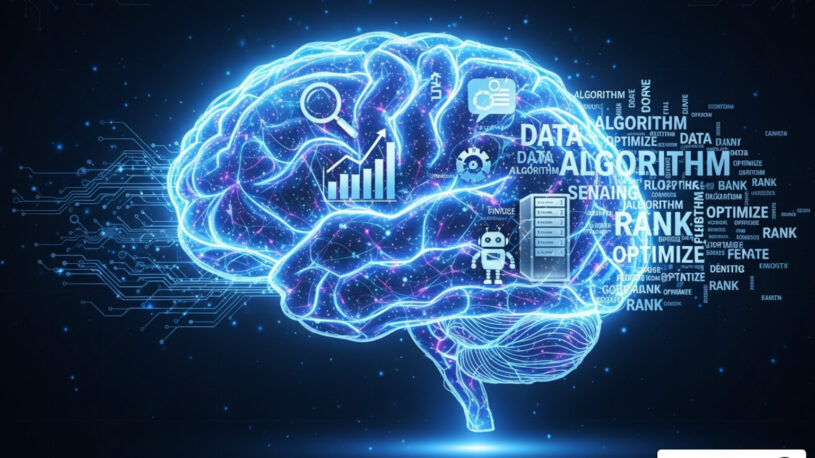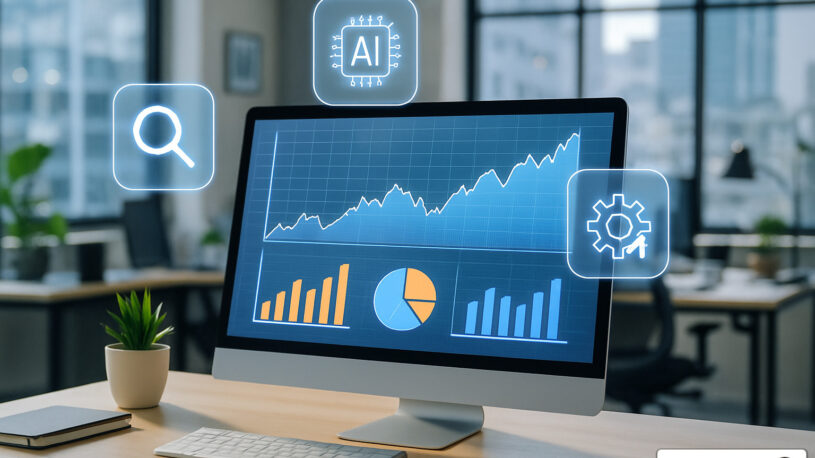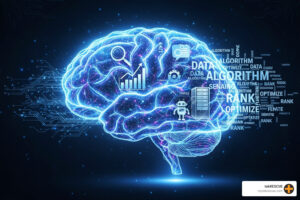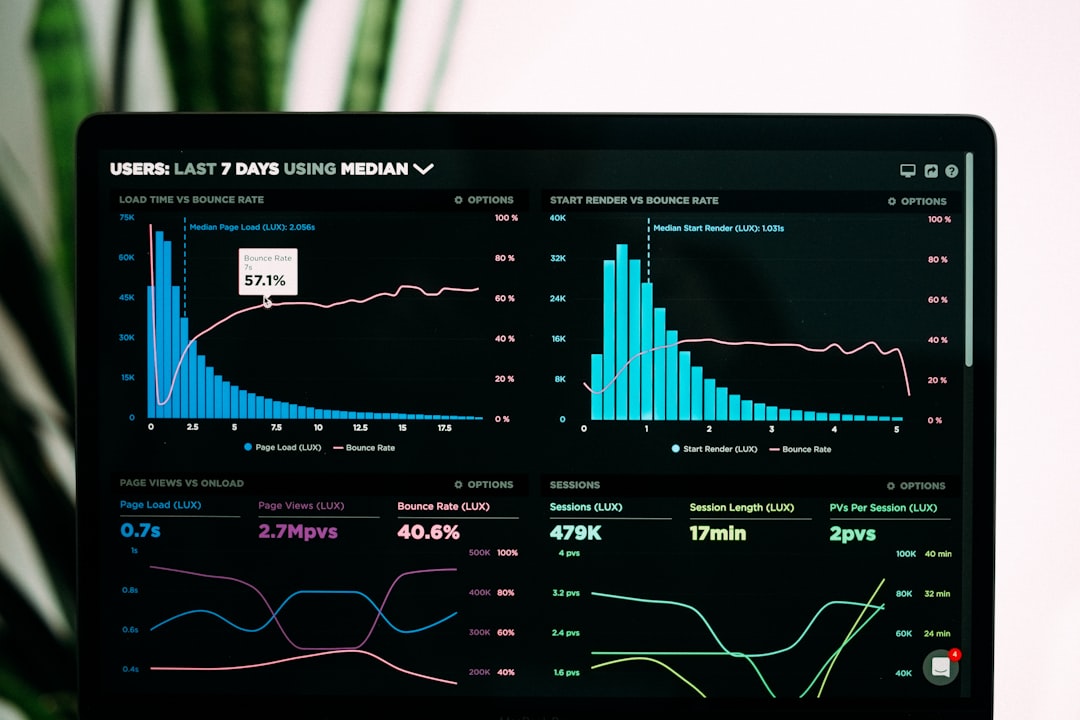

How AI Analyzes Data and Why Humans Should Care
How AI analyzes data is changing how businesses make decisions, compete, and grow. In simple terms, AI analyzes data by using machine learning algorithms, natural language processing, and computer vision to automatically process massive datasets, identify patterns, and generate insights faster and more accurately than traditional methods.
The Quick Answer:
- Data Collection – AI gathers structured and unstructured data from multiple sources
- Data Cleaning – Algorithms automatically remove errors, duplicates, and inconsistencies
- Pattern Recognition – Machine learning identifies trends humans might miss
- Analysis Types – AI performs descriptive, diagnostic, predictive, and prescriptive analytics
- Visualization – Creates charts, dashboards, and reports for decision-making
- Automation – Continuously monitors and updates insights in real-time
The numbers tell the story: 90% of the world’s data was generated in the last two years alone, and businesses implementing AI report 54% cost savings according to recent research. While traditional analytics relies on manual processes and handles mainly structured data, AI can process both structured and unstructured information at lightning speed.
For small and medium businesses, this isn’t just about keeping up with technology trends. It’s about survival. Companies using AI-powered forecasting can reduce supply chain errors by 30-50%, while those leveraging predictive analytics gain competitive advantages their competitors simply can’t match.
AI doesn’t replace human judgment – it amplifies it. The key is understanding how these systems work so you can make informed decisions about protecting your business and growing your profits.
I’m Randy Bryan, founder of tekRESCUE and an AI expert who’s helped businesses understand how AI analyzes data to drive growth and security.
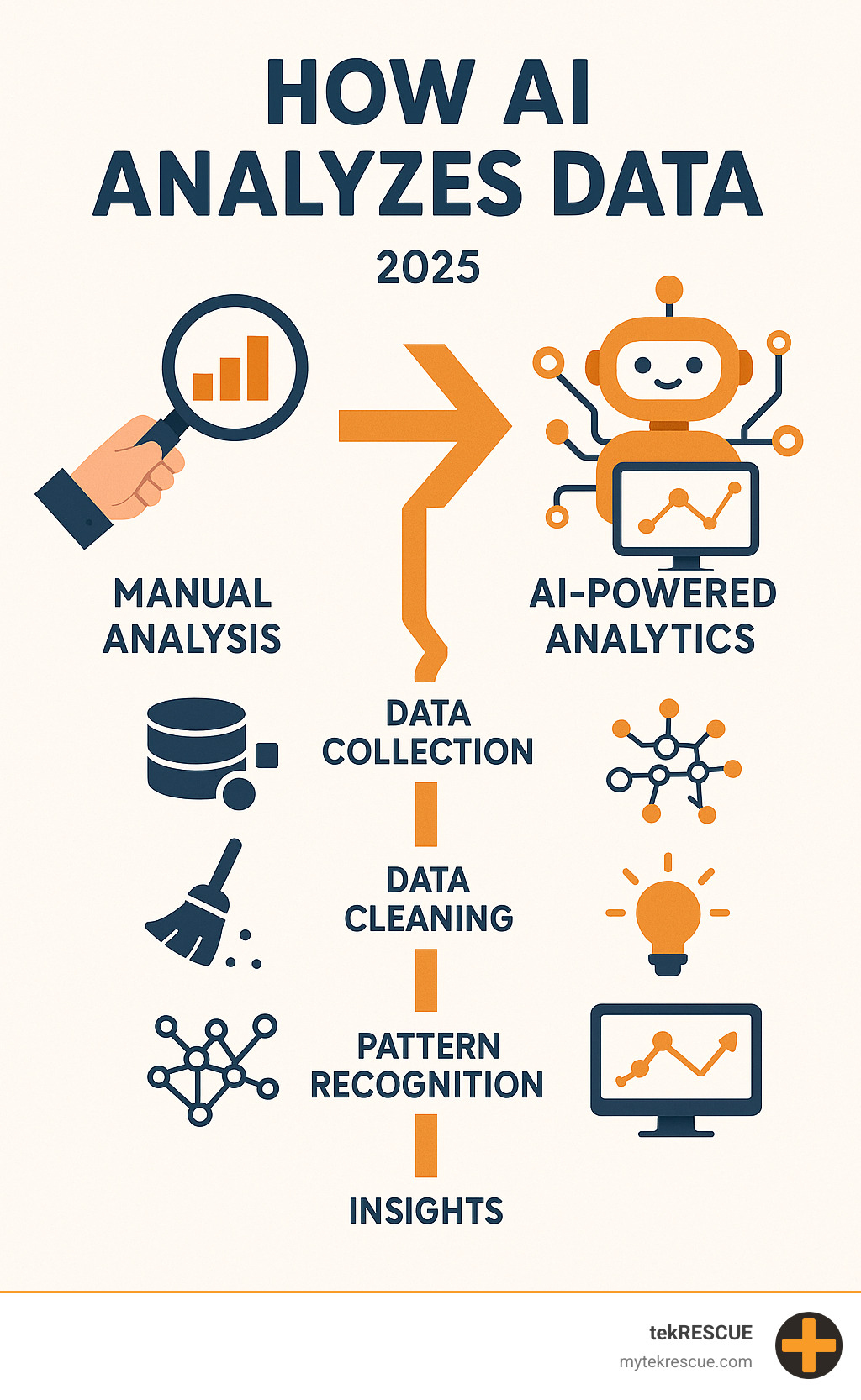
How AI analyzes data: Core concepts & workflow
The four analytics types improved by AI
When I explain to business owners how AI analyzes data, I start with the four types of questions every business needs to answer. These are based on Gartner’s Analytics Ascendancy Model, but AI has completely transformed how we get these answers.
Descriptive Analytics answers “What happened?” Your monthly sales report is descriptive analytics. But AI changes everything: while an analyst might spend days compiling data from different systems, AI does it in minutes. More importantly, AI simultaneously analyzes customer reviews, social media mentions, support tickets, and competitor activity.
Diagnostic Analytics digs deeper with “Why did it happen?” When sales drop, a human analyst might test a few theories. AI tests thousands of possibilities simultaneously. I’ve seen AI identify the real reason behind declining performance: a subtle change in website loading speed that was driving customers away.
Predictive Analytics asks “What might happen next?” Traditional forecasting relies on trends and gut instinct. AI predictive analytics uses machine learning to spot patterns humans can’t see. According to McKinsey research, AI-powered forecasting can reduce supply chain errors by 30-50%.
Prescriptive Analytics goes beyond prediction to recommendation: “What should we do next?” This is where AI suggests the best actions to take, analyzing thousands of scenarios and their potential outcomes.
Key AI techniques powering modern analysis
Machine Learning is the foundation. It teaches computers to learn patterns faster than humans, with perfect memory. The system gets better over time – every new piece of data makes it smarter.
Natural Language Processing (NLP) helps AI understand human language, analyzing customer reviews, support tickets, and social media comments. Before NLP, this unstructured text data was basically unusable for analysis.
Computer Vision gives AI the ability to “see” and understand images and videos. Retail stores can analyze customer behavior through cameras, manufacturers can detect product defects, and restaurants can monitor food quality.
Generative AI creates new content, generates reports, and produces synthetic data for testing. It can generate executive summaries and visualizations automatically, freeing up teams for strategic work.
Anomaly Detection spots unusual patterns that might indicate problems or opportunities. It’s like having a security guard who never sleeps and notices everything unusual.
AI data analysis process—How AI analyzes data
Data Collection – AI simultaneously gathers information from your CRM system, website analytics, social media platforms, customer reviews, IoT sensors, and external sources like weather data. It handles both structured data (organized databases) and unstructured data (emails, social posts, images).
Data Cleaning – AI automates tedious work that traditionally takes 80% of project time, automatically identifying and removing duplicates, filling missing values, standardizing formats, and correcting errors.
Feature Engineering – AI identifies which information pieces are most important and creates new variables that improve analysis accuracy. It tests thousands of possible combinations to find the ones that matter most.
Model Training – The system automatically tests multiple approaches and selects the best-performing option for each specific task. You get accurate results without needing a data science PhD.
Analysis and Pattern Recognition – Unlike traditional periodic reports, AI provides real-time insights, analyzing thousands of variables simultaneously to uncover relationships impossible for human analysts to find.
Visualization and Reporting – AI automatically generates dashboards and reports custom to different audiences. Modern platforms can answer questions in natural language, so teams can ask “Why did sales drop in the Northeast?” and get immediate answers.
Continuous Learning – The system gets smarter over time, learning from new data to improve accuracy. Your analytics investment becomes more valuable as it processes more business data.
For businesses interested in implementing these capabilities, platforms like BigQuery Studio and DataRobot provide user-friendly interfaces. Check out this YouTube video about AI code assistance in BigQuery Studio to see these technologies in action.
Benefits, challenges & getting started
Why businesses adopt AI analytics
Businesses adopt AI analytics for survival in competitive markets where speed and accuracy determine winners.
Speed That Changes Everything – While quarterly reviews take weeks to compile, AI does the same analysis in minutes. When market conditions shift, businesses using AI can pivot immediately while competitors wait for next month’s reports.
Scale Beyond Human Limits – AI simultaneously analyzes thousands of variables and relationships. It spots subtle customer behavior patterns, seasonal trends, and operational inefficiencies that human eyes miss.
Real Cost Savings – The 54% cost savings from AI implementation comes from avoiding expensive mistakes, optimizing operations, and making smarter decisions faster. Predict equipment failures before they happen, forecast demand more accurately, and reduce inventory costs while avoiding stockouts.
Competitive Advantage – AI-powered forecasting reduces supply chain errors by 30-50% compared to traditional methods. This operational excellence can mean the difference between thriving and struggling in competitive markets.
Limitations, risks and human oversight
AI analytics isn’t magic. Understanding limitations helps set realistic expectations and implement proper safeguards.
Data Quality Challenge – Poor data quality is the number one reason AI projects fail. Incomplete records, inconsistent formats, outdated information, and biased datasets lead to unreliable insights. AI-generated reports often look convincing even when based on flawed data.
Bias and Fairness Issues – AI systems learn from historical data, potentially perpetuating past biases. This creates business risks including discriminatory practices, regulatory compliance problems, and missed opportunities with underserved customers.
Privacy and Security Vulnerabilities – AI analytics requires access to sensitive data, creating cybersecurity risks. The case where Samsung employees leaked classified code through AI tools highlights how easily proprietary information can be compromised.
AI Hallucinations – AI systems can generate plausible-sounding insights with no basis in reality. These false insights can be convincing because they’re presented with professional formatting and statistical backing. Human oversight remains critical.
Skills Gap – Implementing AI isn’t just about buying software—it’s about changing how organizations think and work. Success requires training, hiring qualified talent, and managing cultural shifts toward data-driven decision making.
Integrating AI into your workflow & next steps—How AI analyzes data
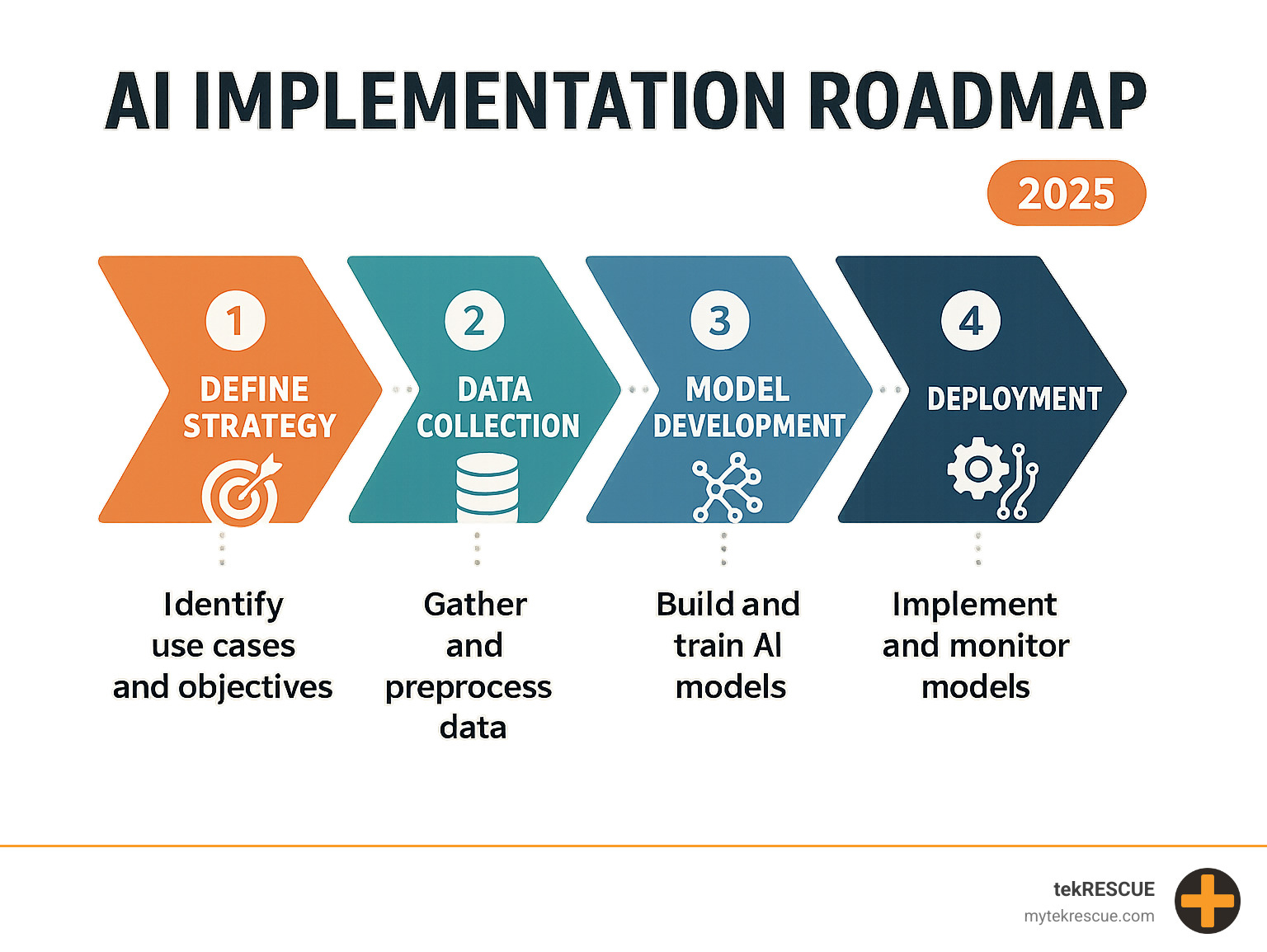
Success comes from taking a strategic approach rather than jumping in headfirst.
Start with Problems, Not Technology – Define specific business problems like improving customer retention, optimizing inventory management, enhancing fraud detection, or forecasting demand. This helps choose the right tools and measure success effectively.
Assess Your Foundation – Evaluate your current data infrastructure. What data sources do you have? How clean is your data? Do you have technical infrastructure to support AI tools? Many businesses benefit from data cleanup before implementing AI.
Choose Appropriate Tools – Consider ease of use for non-technical staff, integration with existing systems, scalability, and cost versus ROI. The best AI tool is the one your team will actually use effectively.
Maintain Human Control – Establish processes for validating AI insights before acting, regular system performance reviews, and escalating high-stakes decisions to human experts. AI should inform decisions, not make them.
Start Small – Begin with pilot projects that have clear success metrics and limited risk. Customer segmentation, inventory optimization, or sales forecasting are good starting points with measurable outcomes.
Invest in Training – Provide comprehensive training on interpreting AI insights, data quality management, cybersecurity considerations, and workflow integration. Technology is only as good as the people using it.
Focus on Business Value – AI analytics is a tool to improve business outcomes. Regularly assess whether implementations deliver expected benefits and adjust as needed.
Your Next Steps
The future belongs to businesses that effectively combine human judgment with AI capabilities. By understanding how AI analyzes data and implementing it strategically, you gain competitive advantages while managing risks.
Start with clear objectives, ensure proper safeguards, and don’t try to do everything at once. Whether exploring AI analytics or expanding existing capabilities, approach implementation thoughtfully.
At tekRESCUE, we help businesses throughout Texas implement AI strategies that drive growth while maintaining security. We specialize in Generative Engine Optimization: AISEO & AIEO and comprehensive AI consulting services that deliver measurable results.
Table of Contents

